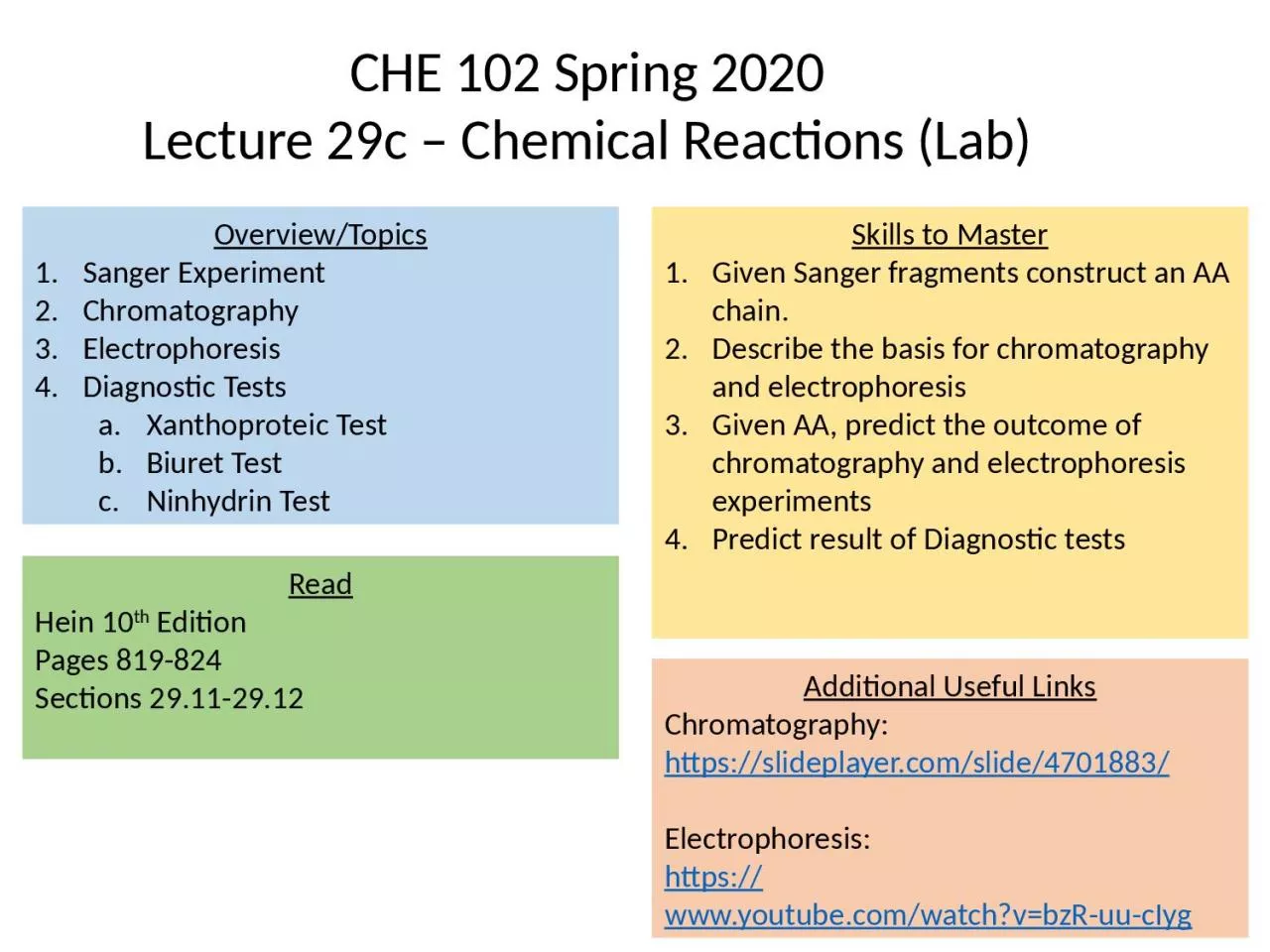

Chromatography Electrophoresis Diagnostic Tests Xanthoproteic Test Biuret Test Ninhydrin Test Skills to Master Given Sanger fragments construct an AA chain Describe the basis for chromatography and electrophoresis ID: 930376
Download Presentation The PPT/PDF document "Overview/Topics Sanger Experiment" is the property of its rightful owner. Permission is granted to download and print the materials on this web site for personal, non-commercial use only, and to display it on your personal computer provided you do not modify the materials and that you retain all copyright notices contained in the materials. By downloading content from our website, you accept the terms of this agreement.
Slide1
Overview/TopicsSanger ExperimentChromatographyElectrophoresisDiagnostic TestsXanthoproteic TestBiuret TestNinhydrin Test
Skills to MasterGiven Sanger fragments construct an AA chain.Describe the basis for chromatography and electrophoresisGiven AA, predict the outcome of chromatography and electrophoresis experimentsPredict result of Diagnostic tests
ReadHein 10th Edition Pages 819-824Sections 29.11-29.12
Additional Useful LinksChromatography: https://slideplayer.com/slide/4701883/Electrophoresis:https://www.youtube.com/watch?v=bzR-uu-cIyg
CHE 102 Spring 2020
Lecture
29c
–
Chemical Reactions (Lab)
Slide2Fredrick Sanger (1958 Nobel Prize) Beef InsulinUsed to determine Primary Structure (#, kind, type, and sequence of AA)Several years of work to sequence 51 AAHydrolyzed (+H2O) proteins into smaller fragments to analyze
Sanger ExperimentNH2-CH-C-NH-CH-C-NH-CH-C-OHO
O
O
+H
2
O
R
1
R
2
R
3
NH
2
-CH-C-OH
O
R
1
NH
2
-CH-C-OH
O
R
2
NH
2
-CH-C-OH
O
R
3
+
+
Can you:
Given AA Chain, hydrolyze it
Read:
29.12
Slide3AA 1AA 2AA 3
AA 4AA 5AA 6
AA 7
AA 8
AA 1
AA 2
AA 3
AA 3
AA 4
AA 5
AA 6
AA 4
AA 5
AA 6
AA 7
AA 8
Original Fragment
Frag 1:
Frag 2:
Frag 3:
AA 1
AA 2
AA 3
AA 4
AA 5
AA 6
AA 7
AA 8
Reconstructed Fragment
Can you:
Given AA Fragments, construct the original AA chain
Slide4You Try It!Given the following fragments, combine them together to forma strand that is 8 AA longTyr
AlaAla
Lys
Gly
Asp
Cys
Ala
Tyr
Gly
Frag 1:
Frag 2:
Frag 3:
Can you:
Given AA Fragments, construct the original AA chain
Slide5Did you get it right?
TyrAlaAla
TyrGly
AspCys
Lys
Given the following fragments, combine them together to forma strand that is 8 AA long
Tyr
Ala
Ala
Lys
Gly
Asp
Cys
Ala
Tyr
Gly
Frag 1:
Frag 2:
Frag 3:
Ala
Tyr
Gly
Frag 1:
Tyr
Ala
Ala
Lys
Frag 2:
Gly
Asp
Cys
Frag 3:
Correct
Answer:
Can you:
Given AA Fragments, construct the original AA chain
Slide6Method to separate compounds (AA) based on differences inSolubility SizeCharge Stationary/Solid Phase – chromatography paperMobile/Liquid Phase – water or ethanolLiquid moves up the solid phase, different compounds travel at different rates depending based on chemical properties
ChromatographyCan you:How are AA separatedTerminologyDescribe a Chromatography experiment
Read: 29.12https://slideplayer.com/slide/4701883/
Slide7Chromatography - Example
AA 1 (Least Polar)
AA 2
AA 3
AA 4 (Most Polar)
Unknown Mixture
Stationary Phase = Nonpolar
Mobile Phase = Polar
Can you:
Show how the AA are separated
Slide8Chromatography - Example
Asp – CH
2
-COOH
Gly
- H
Ala – CH
3
Leu
- CH
2
CH(CH
3
)
2
Stationary Phase = Nonpolar
Mobile Phase = Polar
Can you:
Complete the experiment
Slide9Chromatography – You Try It!
Val
Phe
Ala
Lys
Separation based on size
Small = fast
Large = slow
Can you:
Complete the experiment
Slide10Chromatography – Answer!
Val
Phe
Ala
Lys
Separation based on size
Small = fast
Large = slow
smallest
largest
Can you:
Complete the experiment
Slide11ElectrophoresisCan you:How are AA separatedTerminologyDescribe a Chromatography experiment
Read: 29.5 and 29.12https://www.youtube.com/watch?v=bzR-uu-cIygMethod to separate compounds (AA) based on differences in
Charge (+/-)Size (friction)Gel Matrix (Sieve Like Material)AA move due to electric field (or pH gradient)SDS – separate on size only
Review “Zwitterions”
Slide12Electrophoresis - Example+
-+++
- -Start:
+
-
++
+
- -
End:
Remember:
Opposites Attract
Can you:
Complete the experiment
Slide13Electrophoresis – Example with AA+
-AlaGlu
LysStart:
+
-
End:
Remember:
Opposites Attract
Lys
Glu
Ala
Ala
Glu
Lys
Can you:
Complete the experiment
Slide14Electrophoresis – You Try It!+
-HisTyr
AspStart:
+
-
End:
Remember:
Opposites Attract
Asp
Tyr
HIS
Can you:
Complete the experiment
Slide15Electrophoresis – You Try It (Answer)!+
-HisTyr
AspStart:
+
-
End:
Remember:
Opposites Attract
Asp
Tyr
HIS
Asp
Tyr
His
Can you:
Complete the experiment
Slide16Diagnostic Test – Ninhydrin ReactionSuper sensitive (10-8g)Clear → purple (yellow if Pro)+ any AA- other (carbohydrates/lipids
Slide17Clear → pastels (Easter eggs)+ peptides with 3+ AA- AA or dipeptidesDiagnostic Test - Biuret
12
3
Slide18Clear → yellow/orange+ Benzene rings- Other AADiagnostic Tests - Xanthoproteic